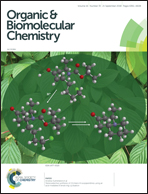Abstract
An efficient two-step palladium catalyzed synthesis of furo[3,2-b:4,5-b′]diindoles, a hitherto unknown symmetrical heterocyclic core structure, was developed. The synthesis is based on a regioselective Suzuki–Miyaura cross coupling reaction of tetrabromofuran and subsequent double N-arylation. Selected compounds were studied with regard to their optical and electrochemical properties. The compounds show fluorescence with high quantum yields and non-reversible oxidation events. The compounds possess similar HOMO–LUMO band gaps compared to their sulfur and nitrogen analogs. Variation of the substituents hardly affects the HOMO–LUMO gap, but allows for some fine-tuning of the electron affinity and ionization potential as well as quantum yields. The compounds prepared represent interesting candidates for the development of organic electronic materials.
![Graphical abstract: Synthesis of furo[3,2-b:4,5-b′]diindoles and their optical and electrochemical properties](/en/Image/Get?imageInfo.ImageType=GA&imageInfo.ImageIdentifier.ManuscriptID=C8OB01737A&imageInfo.ImageIdentifier.Year=2018)
- This article is part of the themed collection: Synthetic methodology in OBC


 Please wait while we load your content...
Please wait while we load your content...